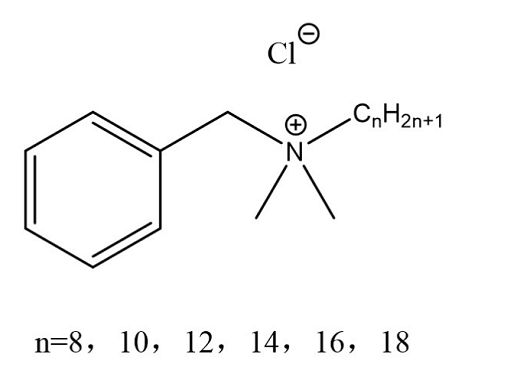Benzalkonium Chloride: A Comprehensive Overview
Introduction
Benzalkonium chlorides (BACs), also known as alkyl dimethyl benzyl ammonium chlorides, alkyl dimethyl (phenylmethyl) quaternary ammonium chlorides, ammonium alkyl dimethyl (phenylmethyl) chlorides, or ammonium alkyl dimethyl benzyl chlorides, are a class of quaternary ammonium compounds (QACs). They are usually commercialized as a mixture of compounds with different lengths for the alkyl chain, ranging from C8 to C18, with higher biocide activity for C12 and C14 derivatives. This article will introduce its application and toxicity.

Figure 1 Characteristics of Benzalkonium Chloride
Applications
Benzalkonium chlorides were reported for the first time in 1935 by Gerhard Domagk, gaining the market as zephiran chlorides, and were marketed as promising and superior disinfectant and antiseptics. In 1947, the first product containing Benzalkonium chlorides was registered with the Environmental Protection Agency (EPA) in the United States. Since then, they have been used in a wide variety of products, both prescription and over the counter. Applications range from domestic to agricultural, industrial, and clinical. Domestic applications include fabric softeners, personal hygiene and cosmetic products, such as shampoos, conditioners, and body lotions, as well as ophthalmic solutions and medications that use the nasal route of delivery.
Benzalkonium chlorides are also among the most common active ingredients in disinfectants used in residential, industrial, agricultural, and clinical settings. Additional registered uses for BACs in the United States include applications on indoor and outdoor surfaces (walls, floors, toilets, etc.), agricultural tools and vehicles, humidifiers, water storage tanks, products for use in residential and commercial pools, decorative ponds and fountains, water lines and systems, pulp and paper products, and wood preservation. The recommended or allowed concentrations of BACs in different products vary considerably according to the application. 1
Toxicity
The toxicity of benzalkonium chloride to humans and other animals has been described in the literature, even though discordant conclusions arise from differences in experimental conditions. BACs are known skin irritants, with occasional, rarer reports as allergens (skin sensitizers). Regarding acute toxicology data, BACs are classified by the EPA as toxicity category II by the oral and inhalation routes and toxicity category III via the dermal route. They are also considered to be highly irritating to the eyes and skin (toxicity category I). Small but significant genotoxic effects in both plant and mammalian cells were observed in vitro for benzalkonium chloride concentrations as low as 1 mg/liter, which is lower than those reported to be found in the environment. Considerable cell toxicity was observed in vitro for human ocular cells exposed to BAC concentrations as low as 0.0001%.1
Besides, benzalkonium chloride has been used in eye drops as a preservative since the 1950s, and in 2011, it is still the most common preservative used in ophthalmic formulations. It is an effective bactericidal and fungicidal agent that helps to minimize growth of organisms in multidose containers. However, it is not selectively toxic to bacteria, and there is increasing evidence that long-term use of this agent can cause or exacerbate ocular surface disease.2
References:
[1] BEATRIZ MERCHEL PIOVESAN PEREIRA I T. Benzalkonium Chlorides: Uses, Regulatory Status, and Microbial Resistance.[J]. ACS Applied Electronic Materials, 2019. DOI:10.1128/AEM.00377-19.[2] MD R N, MBA K V M M. Benzalkonium Chloride in Glaucoma Medications[J]. Ocular Surface, 2011, 9 3: iv-. DOI:10.1016/S1542-0124(11)70025-8.
Related articles And Qustion
Lastest Price from Benzalkonium chloride manufacturers

US $0.00-0.00/KG2025-11-21
- CAS:
- 8001-54-5
- Min. Order:
- 1KG
- Purity:
- 98
- Supply Ability:
- 10000KGS

US $150.00/kg2025-11-21
- CAS:
- 8001-54-5
- Min. Order:
- 1kg
- Purity:
- 99%
- Supply Ability:
- 20tons



